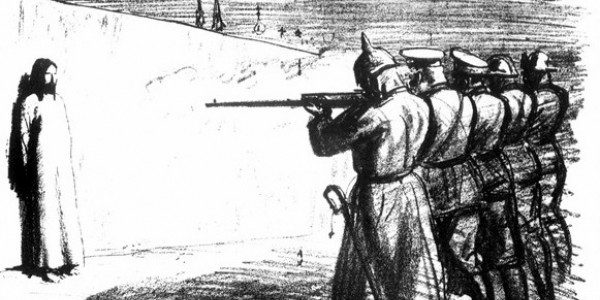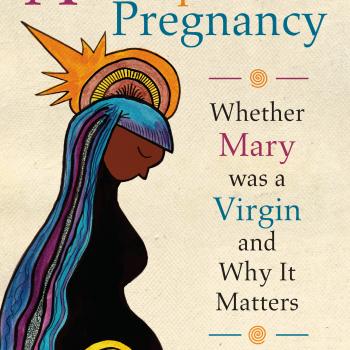Recently I raised the tough problem of violence in the Bible.

The Bible includes a lot of stories of pretty terrible violence–and a whole lot of that violence is done in God’s name, on God’s behalf, or even directly done by God himself.
A brief reminder of a few of the most troubling examples:
The flood narrative: The world’s population apparently wiped out save for a few select people and animals.
God’s law/commands, many of which included capital punishment for lawbreakers.
God’s direct destruction of “wicked” cities such as Sodom and Gomorrah.
God’s “mass murder” of the Egyptians, through plagues in Egypt and the enclosing sea waters during the Exodus.
The genocide of entire nations during the Canaanite conquest narrative.
Let’s focus on this last one. Eric Seibert, in Disturbing Divine Behavior, writes
On more than one occasion, the Old Testament portrays God ordering Israel to utterly annihilate a particular ethnic group, leaving no survivors. This represents what is arguably the most problematic way God operates as a divine warrior, namely in the role of a genocidal general (24).
God’s command to Moses to destroy the nations living in the Promised Land includes the stern wording: “You must utterly destroy them. Make no covenant with them and show them no mercy” (Deut. 7:2). As Seibert suggests,
Yet such a comprehensive command raises serious questions about the nature of God. If this text reflects “what really happened,” as many Christians believe, what does it suggest about God’s character? What kind of God commissions genocide? Such questions are particularly unsettling in light of the many atrocities committed in the twentieth century during the Holocaust and, more recently, in places like Rwanda, Kosovo, and Darfur. Moreover, narratives depicting God as genocidal become increasingly challenging to understand when viewed in light of other biblical stories in which God appears ready and eager to forgive those who repent of their wicked ways (25).
Such narratives also starkly contrast other portraits of God–in the Old Testament itself and in the New Testament, where Jesus commands us to love rather than hate, our enemies. In the Sermon on the Mount, Jesus adds “love your neighbor as yourself” to Deuteronomy’s shema: “You shall love the Lord your God with all your heart, and with all your soul, and with all your might.” Interestingly, the shema occurs in Deuteronomy 6, the chapter prior to God’s command to utterly destroy them and show them no mercy.
This contradiction or tension is what has led many Christians to read the “violent God” passages in the light of the “loving God” passages–and to allow the loving ones to overrule the violent ones. This is a kind of “Scripture interpreting Scripture” approach. A number of early theologians read the violent God narratives as allegories for the spiritual conflict. These stories were not seen as representing actual historical battles, but as reflective of unseen, spiritual warfare.
As Seibert points out, the creative interpretive strategies (allegory, typology, etc.) common in the pre-modern period are rarely used anymore. So we are left with the more difficult question of how to reconcile the violent God with the loving God.
Some say there is no real problem with God; rather, the problem is with us. God can do whatever God wants and since God determines what’s right and wrong or moral or immoral, we simply ought not question God. If God commands violence–even murder–it cannot be a sin. Seibert calls this the “divine immunity approach” to the problem.
Others appeal to the “greater good,” arguing that even though God commanded violence in the OT, it was a greater good (eliminating evil, bringing about salvation, etc.). We have to trust that God knew (and knows) what God is doing here and that there was no better way, no alternative that could have brought about the required result of the people of Israel living in the promised land and from there, becoming a people who witness to the one true YHWH.
Many approaches to the problem focus on the brutal physical and social realities of the Ancient Near East and the seeming inevitability of violence. God was working with people where they were, slowly pulling them forward toward a better ethic and a better way of living. Perhaps divinely-sanctioned violence was a “necessary evil”? This approach fits into the theology of “progressive revelation”; God reveals just enough truth for people to move forward from within their current reality and worldview, etc.
But all these approaches, Seibert concludes, fall short. The most promising of them, the “greater good” approach combined with progressive revelation, does not make sense of the intensity, comprehensiveness, and brutality of the violence God commands and the genocide he apparently sanctions. Sure it’s good to remember that we are not God and that we do not get to determine what God must do and whatever God must be like, but really? Come on.
The violent portrait of God just does not sit well with us. It should not sit well with us.
We know that violence (and war) doesn’t typically solve problems, it usually creates more problems. And we know that violence is just in and of itself not something we want to call “good” or to pursue; rather, we want to avoid it at all costs. We know that war is usually motivated by impure motives not pure ones. We know that aggression in the name of a “God” is something to be suspected not embraced. We know that slavery is wrong, that theft (of land, houses, cities, vineyards) is wrong. And we sense that the divine command to “show them no mercy” runs contrary to the image we have of who God really is.
Was this really God commanding murder and genocide?
No, Seibert says. It was not.
The reports in the OT of God commanding violence, murder, aggression, total destruction, etc., do not give us historically accurate depictions of God’s behavior within history. Old Testament narratives–like most ancient historical accounts–likely tell us far more about the people and places writing down those narratives (oftentimes long after the events described) than they tell us about the events described in the narratives. In Seibert’s words, the narratives “often reveal more about the author’s timeframe than the story’s” (106).
War propaganda was commonly used in the ancient world—if you believed that God was on your side, and that your God was more powerful God, you were more confident to face conflict, difficulty, etc., and you were able to band together more tightly and you were more confident to sacrifice of your own goods and to put yourself on the line for the good of the tribe. OT texts that describe God as sanctioning and commanding war and destruction looks a lot like the genre of war propaganda.
Furthermore, archaeological evidence has revealed that many of the purported battles and destruction of various cities–as recounted in the Canaanite conquest–simply did not happen as the narratives describe. Seibert describes this evidence in detail.
What, then, of the Bible’s authority?
As an evangelical, I was taught to read the Bible and the purposes of each text in light of the genre, nature, and shape of the text. Seibert argues we also have to do that with these violent OT narratives–this war propaganda. And we have to take what we know about these texts from historical criticism seriously.
We also have to ask ourselves what the text is really teaching us. What sort of theology ought we derive from it? But this question can’t be answered in isolation. It has to be answered in light of the cultural and religious worldview reflected in the text and in light of what we know from other biblical texts–in the context of the whole canon.
Seibert provocatively suggests that we draw a distinction between the “textual God and the actual God.” The textual God reflects human authors’ understanding of God; they are limited in understanding by their context and by the very fact of their humanity. This does not make the Old Testament irrelevant for theology, but it means that if we’re going to have a coherent picture of God, we must sort out these tensions (of the violent God and the loving God). The best place to sort out these tensions, Seibert rightly argues, is via the picture we have of God in Jesus Christ.
In Jesus, as the New Testament emphatically tells us, we get the “image of the invisible God” (Col 1:15), a revelation of God that surpasses anything offered in the Old Testament (Heb 1:1-3).
The grid Christians should use to decipher the sometimes confusing picture of God in the Old Testament is Christology. To know what the real God is like, in dialogue with the textual God, we ought to focus our gaze on Jesus and let that flow back into how we interpret the human author’s understanding of their experience with God.
That seems like a pretty good suggestion to me.










